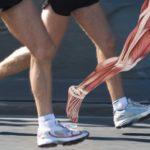Plantar Fasciitis: Anatomy and Function of the Plantar Fascia
By CEO Robert Forster, PT
The plantar fascia is a tight band of dense connective tissue on the bottom of the foot extending from the heel to the base of the toes.
When you move your body forward over a weight- bearing foot, the toes are extended and lifted upward, winding the plantar fascia taut like a skin over a drum. This action helps transform the foot from a flexible structure able to adapt to variations in the walking surface, to a rigid lever that supports the foot while it’s on the ground, by limiting the degree that the arch collapses as the body moves forward over the foot.
How You Feel the Pain
You feel plantar fasciitis as acute pain at the bottom of the heel. It typically occurs in one or both feet when taking the first few steps out of bed in the morning. Pain may improve or disappear after a few minutes of walking around the house, but will often reappear during the day after sitting for a while, and at the end of the day.
Pain may be worse when barefoot or in shoes with poor arch support. The pain may also be present at the start of a running workout and improve as you warm up, which is NOT an indication that you can continue to run. In some cases, the pain may be more in the arch area.
Additionally, some runners will grow a bone spur on the heel where the plantar fascia attaches. Although this may prolong the rehabilitation process, it does not necessarily preclude you from resolving the injury and getting back to pain-free running.
How the Injury Happens
The plantar fascia can be damaged in several ways. The least likely scenario is that it gets bruised and injured by a pointy rock or other obstacle in your path as you walk, hike, or run.
This needs to be addressed with the same rehab procedures used for the more common mechanical cause of injury to this structure.
A very common cause of plantar fasciitis is overpronation, which overburdens the plantar fascia by leaving the foot in a flexible posture with the arch collapsed, just at the time in the running gait cycle when it should be supinated and rigid, which would allow for the efficient transfer of power from the leg to the ground during the push-out phase.
Finally, the most common cause of plantar fascia pain is leg length discrepancy, which will often result in unilateral pain (i.e., pain on one foot and not the other). Leg-length discrepancy will cause one foot to pronate further than the other in an attempt lower the arch and shorten the long leg to correct the leg-length inequality.
Rehabilitation Techniques
Although plantar fasciitis can be one of the most recalcitrant running injuries if left untreated, a quick resolution can often be accomplished if you jump into rehab mode quickly, address the mechanical cause of the leg-length imbalance, and correct your running gait mechanics when you get back to your workouts.
Local treatment with ice and the foam roller and addressing the mechanical cause must be conducted concurrently for this injury to resolve.
The use of heel lifts in both of your shoes, or wearing shoes with more heel height, will take a significant amount of stress off the plantar fascia. Heel lifts of an eighth to a quarter inch (3 to 6 mm) can be purchased at better national brand pharmacies. They must be worn in both shoes.
Summary
Plantar Fasciitis needs to be evaluated immediately. Local icing and PT treatment at the painful site will help, but ultimately we need to address mechanics and leg length discrepancy for total resolution of the problem. We will fix your injury and teach you stretching and strengthen exercises to correct your alignment and work with you to improve your running mechanics.
Call Forster Physical Therapy for your free evaluation: 310-656-8600
Remember, California law allows you to go directly to Forster PT without first seeing a doctor for a referral.









